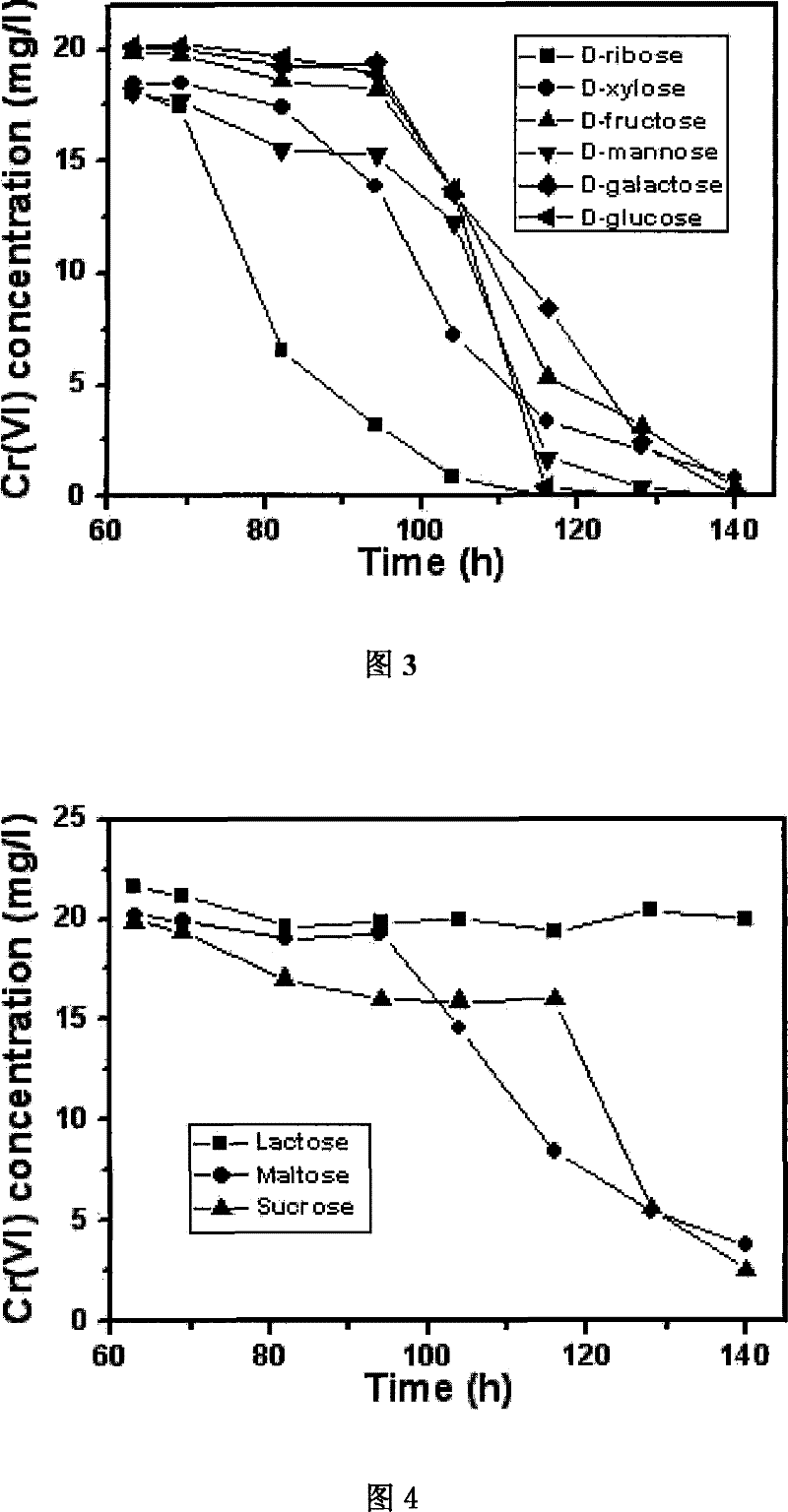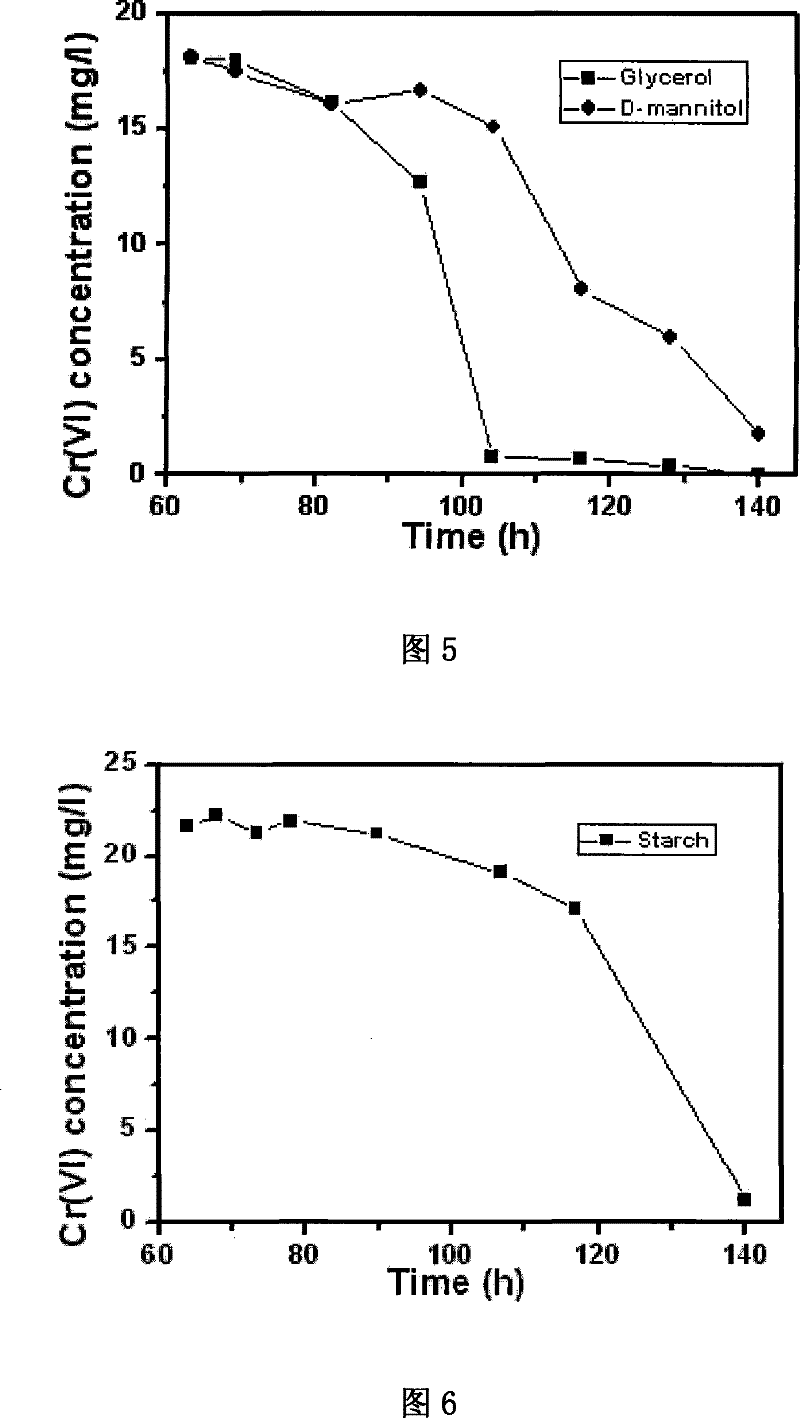Ochrobactrum CTS-325 and culture method thereof and application thereof in reduction of hexavalent chromium
A technology of CTS-325 and Pallidum, which is applied in the direction of bacteria, can solve the problems of increasing operating costs, process operability, and difficult gas control
- Summary
- Abstract
- Description
- Claims
- Application Information
AI Technical Summary
Problems solved by technology
Method used
Image
Examples
example 1
[0024] Example 1. Growth and reduction of hexavalent chromium in four culture media of Pallidum pallidus CTS-325
[0025] 1.1 Recovery of strains
[0026]Take the seed bacteria preserved in liquid nitrogen, insert them into a 100ml Erlenmeyer flask containing 20ml 1# liquid medium (pH 7-8) at a ratio of 1:100, and place them in aerobic, normal pressure, and 30°C conditions. Shake culture overnight in a shaker at 200 rpm to revive the strain.
[0027] 1.2 Cultivation of Paleobacterium pallidus CTS-325 in different media and reduction of hexavalent chromium
[0028] Transfer the resuscitated strains into four 250ml Erlenmeyer flasks containing 100ml of culture medium at a ratio of 1:100 of the bacteria liquid to the culture medium. The composition of the culture medium in the four Erlenmeyer flasks is different. , 1# culture medium (L -1 ): tryptone 10g, yeast extract 5g, sodium chloride 10g pH=7.0~7.5; 2# culture medium (L -1 ): tryptone 10g, beef extract 3g, sodium chlorid...
example 2
[0029] Example 2. Situation of reduction of hexavalent chromium in 1# culture medium by Paleobacterium pallidus CTS-325
[0030] According to Example 1, we selected the 1# medium with the best growth and reduction effect to carry out the following experiments. Different initial concentrations of hexavalent chromium were added to the medium, which were 100mg / L and 200mg / L respectively.
[0031] 2.1 Recovery of strains
[0032] Take the seed bacteria preserved in liquid nitrogen, insert it into a 100ml Erlenmeyer flask equipped with 20ml 1# liquid medium (pH 7-8) at a ratio of 1:100, and place it in aerobic, normal pressure, and 30°C conditions. Shake culture overnight in a shaker at 200 rpm to revive the strain.
[0033] 2.2 Reduction of hexavalent chromium by Paleobacterium pallidus CTS-325 at different initial chromium concentrations
[0034] Transfer the resuscitated strains into two 250ml Erlenmeyer flasks containing 100ml 1# medium according to the ratio of bacterial sol...
example 3
[0037] Example 3. The situation of reducing hexavalent chromium in the optimized 1# medium of Paleobacterium pallidus CTS-325
[0038] In order to solve the problem that Paleobacterium pallidum CTS-325 cannot completely reduce hexavalent chromium in 1# medium, we optimized 1# medium. By adding xylose or sucrose to the 1# medium, or the bagasse left over from the production of xylose and sucrose, it was found that the effect of reducing hexavalent chromium in the optimized 1# medium of Pallidum bacillus CTS-325 was significantly improved, and Hexavalent chromium can be completely reduced when the initial hexavalent chromium concentration is 100mg / L and 200mg / L respectively.
[0039] 3.1 Recovery of strains
[0040] Take the seed bacteria preserved in liquid nitrogen, insert them into a 100ml Erlenmeyer flask containing 20ml 1# liquid medium (pH 7-8) at a ratio of 1:100, and place them in aerobic, normal pressure, and 30°C conditions. Shake culture overnight in a shaker at 200...
PUM
 Login to View More
Login to View More Abstract
Description
Claims
Application Information
 Login to View More
Login to View More - R&D
- Intellectual Property
- Life Sciences
- Materials
- Tech Scout
- Unparalleled Data Quality
- Higher Quality Content
- 60% Fewer Hallucinations
Browse by: Latest US Patents, China's latest patents, Technical Efficacy Thesaurus, Application Domain, Technology Topic, Popular Technical Reports.
© 2025 PatSnap. All rights reserved.Legal|Privacy policy|Modern Slavery Act Transparency Statement|Sitemap|About US| Contact US: help@patsnap.com



